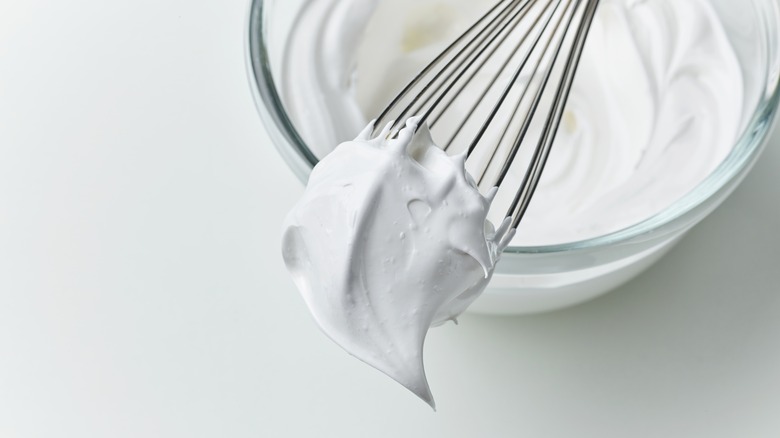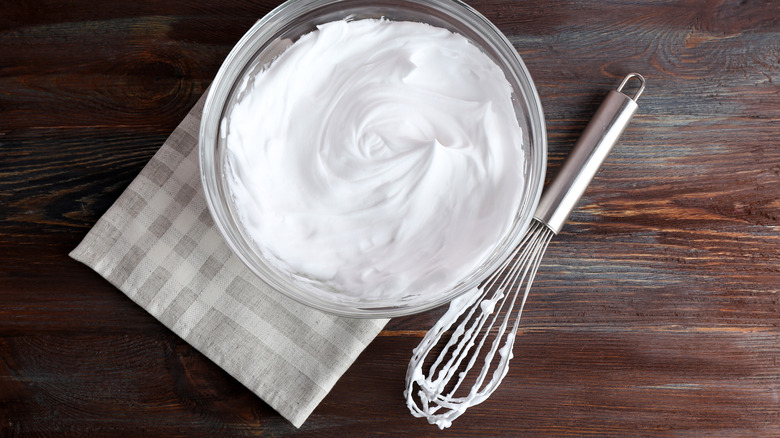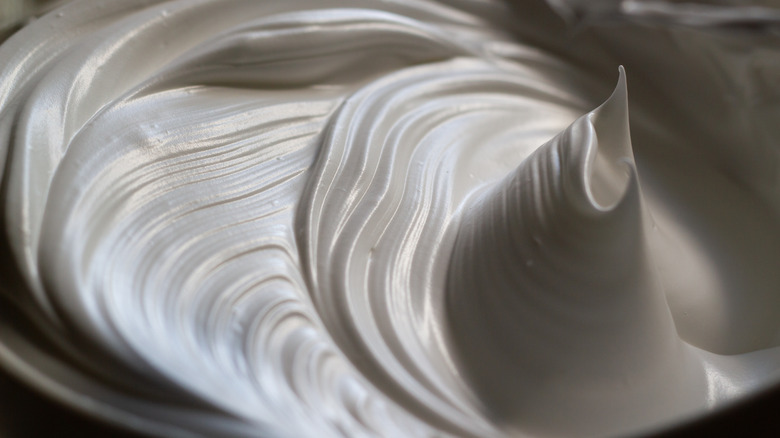Why The Type Of Bowl You Use Matters When Beating Egg Whites
As those of us who enjoy a good lemon meringue pie will attest, egg whites literally have the ability to rise to the occasion when pressed into service. Other than meringue pie, beaten egg whites play a showstopping role in picture-perfect pavlovas, dainty macarons, and in mouthwatering servings of Eton Mess.
Chemistry is the reason liquid egg whites can be coaxed into a mound of shiny white meringue. Per Bon Appétit, egg whites (albumen) begin their journey as 90% water and 10% protein, along with bits of micronutrients. And while it doesn't look like much, it is the proteins in the albumen that transform the egg whites by introducing air, allowing them to get to the heights they were meant to reach.
In Mama's Kitchen says "beaten egg whites" were mentioned in a cookbook for the first time in the 16th century, when an English aristocrat named Lady Elinor Fettiplace talks about making "white bisket bread" using "the whites of twelve eggs beaten verie finelie."
And they may have had no way of knowing this at the time, but these pre-modern day cooks may have used the best bowl to make egg whites, and that hasn't changed to this day.
What bowls are best for egg whites?
Pre-modern day cooks might have found the best way to beat egg whites so they transform from liquid to near solid. Bon Appétit says if you really want to beat your egg whites by hand, the best bowl to use would be one made with copper, because egg white proteins interact with the copper, resulting in a stable foam.
If you don't have a copper bowl handy, Incredible Egg says a stainless steel or glass bowl will do the trick too. Plastic is a no-no because it can hold grease, which The Spruce Eats says will keep whites from becoming big and fluffy.
Other than its material, a bowl's size and shape also matter. The bowl has to be big enough to accommodate the growing mass of egg whites, but the beater or whisk still needs to be able to reach as much of the egg white mass as possible. The Los Angeles Times recommends using a "deep round-bottom bowl" since egg whites can multiply to seven times their original volume.
Getting your whipped egg whites right
But using the right bowl is just one part of the equation if you want to get your egg whites to where you want them to be. Start by separating the egg whites from the yolks very carefully, since, as we mentioned earlier, fat (like egg yolks) tends to keep whites from rising too much, although Bon Appétit says a bit of yolk won't hurt too much.
If you're using a mixer, The Spruce Eats suggests you start slow, and then pick up speed when the eggs become bubbly; keep beaters spinning on high until the whites are at the consistency you want. You can also use a balloon whisk to beat egg whites by hand — whip them quickly and in a clock or counter-clockwise motion so air is incorporated quickly.
Like whipped cream, whipped egg whites can reach several stages of consistency. They can be foamy with a bit of liquid; egg whites can have soft peaks — which means they won't slip out when the bowl is slanted. They can also be firm, which means when you take your beaters or whisk out, the whites stand at attention. Just be careful not to overbeat the egg whites, because like overbeaten whipped cream, egg whites can also collapse and when they get to that point and you would need start all over again with a fresh batch of egg whites.


